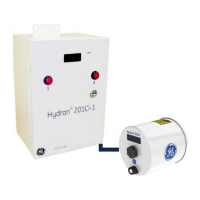3.5 Analog Inputs and Output
3.5.1 Analog Inputs
The Hydran 201Ti uses three analog inputs:
• Gas level reading (supplied by the Hydran 201 sensor).
• Temperature of the H201 sensor (supplied by the sensor thermistor).
• Temperature of the heating plate (supplied by the heating plate thermistor).
All H201Ti’s inputs pass in a first level of processing which has the following functions:
• To protect the H201Ti against interferences and surges.
• To filter out (low-pass) the noise from signals.
• To convert the signals in voltage.
• To amplify the signals
Next, the signals go through an analog/digital converter so the microprocessor can use
them.
• Two calibration constants (offset and slope) are used to convert the signal from
the H201 sensor.
• Three calibration constants (short circuit, open circuit and a mid-scale value) are
required to convert (nonlinear) the signals from the thermistors.
The sensor signal is in microvolt (µV). It is first divided in two scales; then, these two
signals go through the analog/digital converter and finally the two digital values are
read by the microprocessor. The two scales are:
• Low scale, which ranges from 0 to 4,000 µV.
• High scale, which ranges from 0 to 40,000 µV.
The thermistor signals are in ohms (Ω; 3,000 Ω at 25 °C). These two signals also go
through the analog/digital converter and are then read by the microprocessor.
3.5.2 Analog Output
The isolated (up to 2,000 V RMS) analog 4–20 mA current output can supply a load
ranging from 0 to 500Ω (10 V maximum). It is used with a SCADA system.
For details on how to use the analog output, see Appendix G; for wiring details, see
Table D - 6 in Appendix D.

